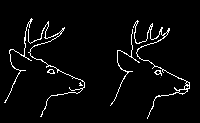Judging Whitetail Deer for Age and Gross R&C Score
I. Constributions to Gross B&C Score:
("TBMI = pneumonic)
- 40%-Total TINE lengths on main frame, esp. brow tine length.
- 30%-BEAM Iengths
- 20%-Beam circumference or MASS - a buck gets 4 H-measurements;
- 10%-INSIDE spread
Ear Length = 7 inches (base to tip)
Eye Diameters = 1 ½ inches
Basal diameter of l eye diameters = 4 ¾ inches circumference
Basal diameter of 1 ½ diameter = 7 inches circumference
The H-4 for 8-pointers is ½ the distance from center of G3 base to tip.DON'T CONSIDER BROW TINES IN QUICK-COUNT FOR NO. OF POINTS
2 up tines = 8 PT.
3 up tines = 10 PT.
4 up tines = 12 PT.
45% of total beam length occurs BEFORE the main beam curves
55% of total beam length occurs AFTER curve
Ear tip to ear tip = 15 inches
If the main beam is 5 inches in circumference at the base, then total mass score will be close to 40 inches
II. Teeth Aging on the Tongue Side:
Reliable within one year
Age 3 ½: 4th tooth, Dentine > lingual enamel; 5th tooth has little wear
Age 4 ½: 4th & 5th tooth show significant wear (dentine > enamel), 6th shows no wear.
Age 5 ½: 4th, 5th, and 6th tooth show wear; some residual enamel in 4th. the oldest tooth.
Age 6 ½ and older remember: The 4th tooth is the key! 4th tooth completely smooth, no enamel in center.
III. Aging Does:
1 - ½ Yearling - smaller, produce bucks, have a maiden appearance (1/4 fawn).
2 ½ - 3 ½- young does, produce at least single fawns, have ears well proportioned to their body.
4 ½ - 6 ½ - mature - muley (long ears), produce most of the fawns and are socially dominant.
7 ½ - older - Old and over-mature: pot belly, sway back, rough coat, short ears, short legs, loose face and neck skin, walk slowly.
- remove these from the herd.
IV. Aging Bucks:
1 ½ All yearling bucks are inside their ears!- < 14 INCHES; A yearling buck weighs 70-100 lbs.; they socialize with does, looks like a doe with antlers.
2 ½ - most 2 ½ year olds are also < 14 inches -underdeveloped necks, legs appear too long for their body, long legs, thin waist/slim waist, seldom shows dominance.
3 ½ - Well-conditioned thoroughbred race horse; muscled neck, not yet highly developed; most dominance signs toward peers or younger, and thin waist, long legs, distinct junction between neck and shoulders, antlers outside ears.
4 ½ - Behavior changes dramatically, becomes totally nocturnal, careful, sticks to cover, has reached full body weight, combative.
5 ½ - Like a middle aged 50-year old man, saggy belly, slow walking, high neck and shoulder development, looks like a NFL line backer, appears hot to have a neck, head blends right into shoulders, looks like all neck and shoulders, as a result, body appears short, legs seem too short, has an "ATTITUDE", approaches other bucks with a sideways gait, often travel with a "toadie" - smaller, younger buck; NO LOOSE SKIN ON FACE AND NECK.
6 ½ - Harvest without fear for the genetics of the herd, old bull, slow gait, swings front legs side to side, all shoulders, loose sagging skin on face, neck and shoulders, legs appear much too short for their body. "SQUINTY" EYES-ALWAYS! All other bucks' eyes are rounded!
7 1/2 - Bony hips, rough coat, arthritic, may increase horn size
2 ½ - +140
3 ½ - +24
4 ½ - +18
5 ½ - +9
6 ½ - +6
Some bucks peak and stabilize early, some improve yearly, some bloom only at maturity. The Hanson buck was 4 1/2 yrs. old!
V. Generation time required to show managed herd improvements is 3 years
A significant jump in quality requires two generations or 6 years.
Note: All bucks Want to be a 130 class 8-point at 4 1/2 years old.
VI. Management Buck Characteristics:
- less than 10 points (any 8 or 9 point buck)
- absent or short brow tines especially if pointing backwards
- short tine length
- G 2's shorter than G 3 (depending)
South Texas Deer Movement
I. Shed velvet - September 10 through September 15
II. Pre-rut Period - October 1 through November 31, stand hunt feed sources, rubs will begin.
III. Rut
- Scraping Period - December 1 to December 13
- Rattle and grunt with high wind just before and after peak of rut
- Best breeding period - Monday, December 14 through Thursday, December 24, daylong random movement, trailing does, 70% does are bred. Lasts two weeks.
- "Secondary Rut" - ALERT!! January 9 to January 24, more big bucks
- Tertiary Rut - February 4 to February 14. Hunting strategy: Increase time hunting, hunt does at major food sources, RATTLE HORNS
IV. Post-Rut Period - January 4 to April 15
- Ends with horn-dropping up to early April to May 1 in South Texas
- Lull, feeding frenzy; deer will go rniles for food
- Stand hunting is best
- Still hunt on windy and rainy days into the wind, use Bean's Maine Guide Boots
V. Field Judging System:
- Main Beam Length
- Total Tine Lengths X 2 + Inside Spread = Gross B & C Score
- Four mass measurements minus deductions for asymmetry for typical scores, plus asymmetrical point score for nontypicals (170 + 195 minimums for the "Book")
Physical Characteristics of Bucks by Age Class
Overall body appearance changes seasonally and with age. Judging the general overall appearance and specific body characteristics allows placement of bucks into one of several age classes. By season end, older bucks may lose up to 25 percent of, their body mass because of rut activity.
The 1 ½ - Year-0ld Buck (Yearling)
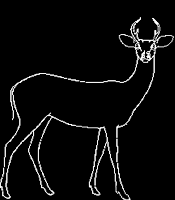
- A "doe with antlers," with thin hind quarters and long, thin legs.
- Artier spread is less than 13 inches (well inside relaxed ear width).
- Enters food plots earlier than older bucks.
The 2 ½ - Year-0ld Buck
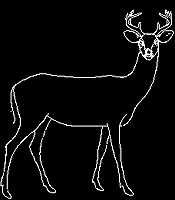
- Antler spread is typically within ear tips.
- Limited amount of neck swelling.
- Waist or area just in front of the back legs is relatively thin.
The 3 ½ - Year-0ld Buck
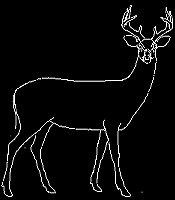
- Antler spread is typically outside ear tips.
- Neck is thickly muscled.
- Looks similar to a well-conditioned race horse.
- Waist Line is not quite as deep as chest
The 4 ½ - Year-0ld Buck (Yearling)
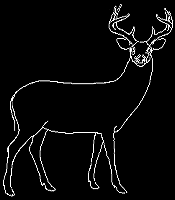
- Obtained all of adult body mass.
- Lost the race-horse Look.
- Neck is fully muscled and blends into the shoulders.
- Waist line is as deep as chest.
The 5 ½ - 6 ½ - Year-0ld Buck
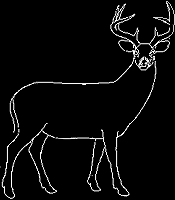
Mature or Prime
- Neck blends completely into shoulders, and front half appears to be one Large mass.
- Legs appear shorter than in younger deer.
- Exhibits a sagging belly and squinty eyes.
- Shows battle scars, such as torn ears, broken antler tines, and scratched neck.
Overmature
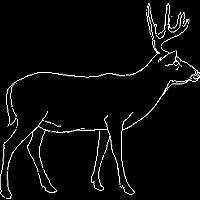
- Body characteristics tend to revert.
- Muscle tone is lost in the neck area.
- Back is usually swayed and shows a prominent pot belly.
The Quality Deer Management Approach
Selective harvest is the key to controlling over-population and improving sex ratio.
Hunters must:
- Estimate the age of bucks on the hoof.
- Avoid the harvest of buck-fawns.
- Reduce the harvest of young bucks.
- Harvest an adequate number of does.
Tips to avoid harvesting buck fawns
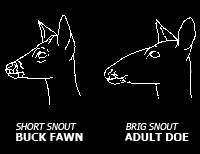
- Do not harvest lone antler-less deer; adult does rarely travel alone.
- Harvest the largest antler-less deer from a group.
- Older does may have short ears, a sway back, and a sagging belly.
- A fawn's snout is shorter than an adult doe's snout making the fawn's ears appear larger.
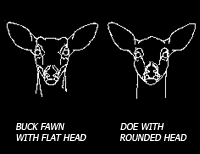
- Watch fawn's forehead for developing antler bases or pedicles.
- Face on, buck fawn's head appears flat between the ears; doe's head appears more rounded.
Tips to judge antler size
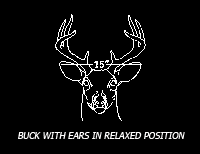
- Ear length compared to tine and beam length - a buck's ear from base to tip is about 6 inches.
- Ear width compared to inside spread-tip-to-tip distance between ear tips is 15 inches.
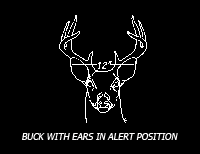
- Alarm behavior reduces tip-to-tip ear width down to about 12 inches.
- Number of antler points - From the side, count the number of points projecting upward. Two on each side will likely be an 8-point buck. Three on each side will Likely be a 10-point buck.
